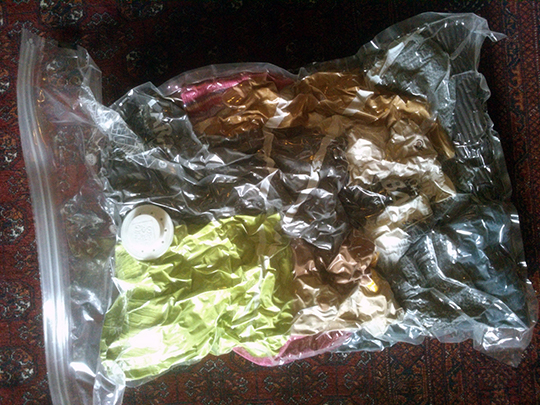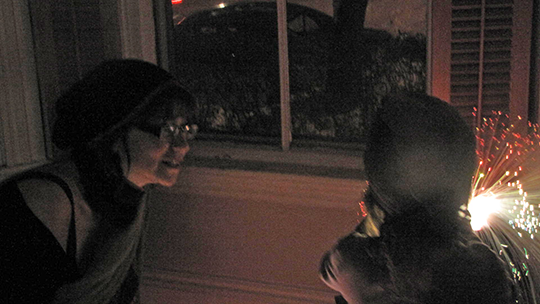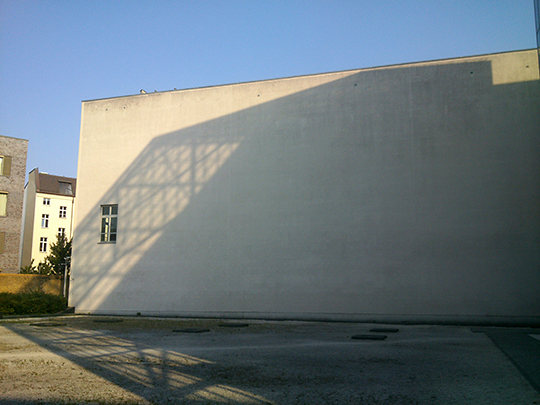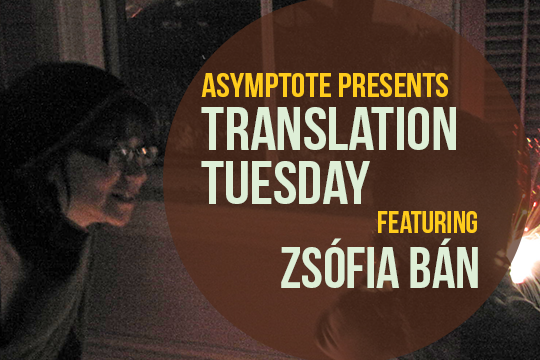An award-winning fiction writer, essayist, and critic who grew up in Hungary and Brazil and now teaches American literature, Zsófia Bán is no stranger to forking paths; the roads not taken. Her beautiful essay below segues quickly from house-moving to the broader and richer philosophical theme of derailment against the backdrop of the ongoing refugee crisis. We hope you like it as much as we do.
* * *
In memory of Svetlana Boym
Tumultuous, yes, tumultuous is what the summer of 2015 was. An unruly, riotous, tempestuous, bewildered summer, ravaged by the lack of order. Only the weather would not stir, hellbent on keeping up the atmospheric conditions prevalent since the beginning of summer. All heat records were broken, with temperatures close to 40 degrees recorded in July and August. We were clearly making meteorological history in Europe. The dull blanket of heat paralyzed our reason just enough to keep us from realizing the obvious until it was too late: history was being made, quite apart from the weather. In fact, the masses, the tumult of refugees pouring through the southern border, then the large families stranded in railway stations in the heart of our city, the gathering of desperate, exhausted people robbed of almost all their possessions warned us clearly enough, that this was the time, here and now, of fateful events. As we were leaving the paralyzed city and the country, we too were facing a journey, though rather than flight, it turned out to be a return: the compulsive, perpetual return to memory, to absence, to the relentless rigor of facts.
On August 3 we packed the car and set out for Berlin. With an ingenious space-saving trick we packed the child’s plush animals into plastic bags shrunk with a vacuum cleaner, so even the plumpest specimens were docilely flattened to two dimensions.

Photograph by Zsófia Bán
Once taken out of their plastic bags upon arrival, they slowly regained their original dimensions: the breath of life gradually returned into them. Zserbó, the giant owl was the first to come to, then Dr Czuki-Czukermann, the anteater and finally Menyus, the ferret, Pöpe, the parrot and the rest, the whole sizeable coterie. The child greeted each miraculous resurrection with a dance of joy: her friends were saved, we had outwitted Archimedes or one of those types. The death news that came the day after our arrival flattened us to two dimensions the same way, except we held no hope of ever regaining our original shape. Remembrance, however alive, is inevitably flatter than the tumultuous nature of presence, the noisy, confusing, disorderly and yet, by virtue of the senses, coherent presence which only one word fits: the person’s name. The name that refers to the single being who is the sum of her traits: the voice, the gait, the colorful fabric of her mind, the fears and desires, the betrayals of the body, the dreams, and the loneliness. Her name is a message inscribed in stone, the imprint of sea-waves on prehistoric geological strata.

Photograph by Zsófia Bán
In our own lives prehistoric times mean the times before life became story, history. Whatever can be told becomes hopelessly two-dimensional, however fresh and lifelike the story. The smells, the scents still linger for a while on a necklace or jacket. We preserve them, keep sniffing them, but before long they take on our own smell; the memory of the voice fades out until it merges into our own inner voice, like the water of a river into its delta.
The Spree flows into the Havel, the Havel into the Elbe, the Elbe into the North Sea (upwards!); then the northern waters merge with the southern waters, and we with all the waters. We will all be together, that’s the idea. I murmur this, standing on Monbijou Bridge from which I throw a flower into the water in her memory. Unexpectedly the flower lands on the deck of a ship emerging from under the bridge; this hurts me to the quick, a glitch, but I soon realize the value of error and roll with it: this way it will reach its destination sooner. For it was precisely errors, the epiphanies of technical and historical glitches, out of which S. constructed theory—and life—, according to which the unexpected errors, derailments open the way to other solutions, other versions, other possibilities, a phenomenon she labeled “off”. Not post-, anti-, neo-, trans-, and sub-, but off. The moment of epiphany, to quote S, gives us the gift of a time out of time, which is invaluable. And although she used the concept off to explore the unrealized, potential events, the undeveloped, unexploited but possible processes and side-alleys of modernity (off modern), the concept is just as appropriate for examining the phenomena of life, for envisioning the script of “what if”, and for underscoring the necessity of ceaseless experimentation.[1] The movement of off, S. writes following her beloved Shklovsky, can best be compared to the lateral movement of the knight in chess.[2] Of course, the off moment par excellence, the technical and historical error (fatal error) of life is none other than death, especially sudden, untimely death. (“Off is about life caught unawares.”) This is no longer what she says; I am saying it, in light of the events. Or rather, in the darkness of the events. (rouge)
The Spree flows into the Havel, the Havel into the Elbe, the Elbe into the North Sea, which is a stone’s throw from St. Petersburg, Петербург (here her throaty, ironic voice suddenly softens) that she left behind at the beginning of the 1980s, only 18 years old. If she left it behind, she did not leave it in place. For everything that she would write and think later, every single sparkling idea of hers was conceived in that city only to be realized in a world new and foreign to her. Her best-known work, The Future of Nostalgia, that turned her name into a brand all over the world, studies the forking paths and potentialities of emigrant life, exile, and historical memory.[3] In her own terms: the possibilities of reflective nostalgia which alone can generate the necessary critical distance between the object of nostalgia and the time of the remembering subject, as opposed to the stale, ahistorical, yet dangerously contagious example of restorative nostalgia. “Criticism is a matter of correct distancing”, writes Walter Benjamin, one of the important inspirations for S.’s ideas.[4] Here too she was already engaged with the idea of off: what happens, what might happen when a destiny, a life, or history leave their usual riverbed and create tributaries that continue through new, unfamiliar terrain. As for ourselves, this tributary is Berlin now for a year—hardly unknown terrain, though under a new constellation. Anything can happen.[5]
We make an overnight stop outside Prague, and stroll for hours in the park of Pruhonice castle. A magnificent construction, designed with an engineer’s perfection, yet coming across as entirely natural, performing the naturalness of nature. We pick at random one or another of the winding, Borgesian paths interlacing the park; our choices do not make our task easier, for as we walk down the chosen paths, the creeping melancholy of renunciation, the eternally unanswered question of “what if” lingers. The artfully designed sudden vistas, the abruptly opening, spacious clearings, the purling creeks complete with tiny waterfalls, the rock gardens in bloom, the viewing points, the arbors and the carefully planned, rich combinations of the greenery give unforeseen delight at every turn. Still, deep in the recesses of our consciousness there lurks the missed experience of the paths not chosen, the nostalgia for experiences never had. We quickly decide that we will stop over again on our next visit home and will try to explore those as well. In vain, of course, for we are unable to discover all the paths of the park on a second and even a third visit, and that’s the way it should be. The architect had outwitted us, cunningly incorporating in the design the natural sense of opacity and unfulfillment, and this is indeed what completes the experience of the park. Similarly, S.’s off experiments with thinking and genres attempt to map such paths not taken from a historical or cultural-historical angle, at times in reference to her own life. “I want to be an artist too,” proclaims a color neon sign at one end of Monbijou bridge, unexpectedly summarizing S.’s yearnings. This was the path, more than any other, whose secret enticed her the most a path she did not have enough time to walk down. Within a year, the disease would rush her mercilessly down a different path, much against her will. I can’t help thinking that the correspondence of off would have crossed her mind, at least fleetingly, there on that American hospital bed, far away from the shimmering Saint Petersburg light, and that this might have come as a consolation. Untidy as she was in daily life, she loved when phenomena were revealed in some unanticipated order, in small epiphanies of correspondences. These made her happy, and perhaps consoled her to some extent for her losses. (rouge)

Photograph by Svetlana Boym
While driving from Budapest to Berlin, I am waiting for the phone to ring (fearing it), waiting for news. In the car CD player the audio book Fancsikó and Pinta is playing for the umpteenth time, read by none other than the Master’s voice[6], in the best of all audiobooks ever made of it. His inimitably playful, ironic accents are dispersed beneficially in the car cabin lined with anxiety, though unable to ease the anxiety caused by his own illness. “Cut the poetry, Fancsikó!” says the Master gently, and I continue listening to the CD all the way to Berlin, again and again, like one desperately holding on to the reassuringly familiar string of words. This melancholy mixed with irony and lightness used to be S.’s mother tongue, too; this was the common language that guaranteed diasporic intimacy between us. She launched this concept in her supremely beautiful essay on the friendship of Mary McCarthy and Hannah Arendt[7]—my favourite among her works, as I told her in a message sent to the hospital. Our messages went by strange, mysterious routes: this one I sent to a common friend of ours who happened to be in Estonia at the time, and she transmitted it to the one who could be permanently by S.’s bedside in Boston, unlike us. My messages would travel to her along immaterial, virtual pathways, and she would send word by the same paths, yet our words never failed to reach their destination. When hearing my message—she was no longer able to read—her face lit up [I read], this was, she said, her own personal favorite too. It is the intimacy of diasporic people that allows for strong bonds to be created even with friends living on a different continent, whom we see only very rarely. “The recipes of friendship are always imprecise,” she writes in this essay and indeed, friendship would sometimes find itself highly unusual ways, overflow its riverbed and show up where we least expect it. “Cut the poetry, Fancsikó!” the Master’s voice warns us as I fix my eyes on the highway, holding on to the steering wheel. Who would arrive there first, her or us? The phone is silent.
Crossing the Monbijou Park from the direction of the old synagogue on Oranienburger Strasse, we are walking toward Monbijou Bridge. Mon bijou, my jewel, my precious. A surprisingly flimsy, buoyant name for a Berlin bridge, it almost seems an error, a faux pas of naming. Each of us is holding a flower, awaited by the busy Spree. We stop at the middle of the bridge and look down on the turbid green water. Then one of us starts relating our friend’s last day the way she, too, had heard it from someone else. The transmission of the moment of death takes the form of some ancient ritual in the glaring hot summer afternoon, the handing down of a tradition from one human being, one spirit to another, from the one already dead to the living; we cannot see anything but only hear the sound of words dissolving in the air, just as the religion of our forebears is based not on sight but on hearing, Hear, o Israel, here and now these earthbound words, close to the body, will serve in place of a prayer. In such and such a way it happened. When she finishes she looks at us questioningly, what next. And it is as if S. herself had transmitted the solution, applying lipstick was her small, profane rite, performed countless times every day; she would carefully put on lipstick, whether she was going to the store, to teach, to a meeting, she insisted on her lipstick even on Skype, she wouldn’t want to appear naked, as it were, and probably didn’t know how much her stubborn insistence on wearing make-up denuded her. “In the last analysis appearances is all there is,” she would enjoy quoting Brodsky. They say that even in the hospital she worried she would run out of lipstick—rouge à lèvres. Mon bijou. I fish a lipstick out of my bag, pass it around, we all apply it without a mirror. Some of us smudgily, not quite following the line of the lips: a bit off. Then we throw our flowers into the water.
The Spree flows into the Havel, the Havel into the Elbe, the Elbe into the North Sea. Later I would inherit from her, together with the dark red leather jacket, a lipstick in a golden tube, Raisin rapture 892, L’Oréal, Paris. All further messages from me are sent to this address. The heat is long over, Berlin is snowed in, the smaller lakes are frozen. Along Hungary’s southern borders an imperious razor wire fence stands; Europe and everything that represents the European idea is perhaps on the verge of falling apart. We don’t know where to live, where to go, perhaps we will always be exiles from now on, inside or outside the iron curtain. There is only one thing that guides us, its warm, now stronger, now dimmer glow, its playful chiaroscuro has a preserving power even after it has turned to memory.
“Writing about men and women in ‘dark times,’ Arendt observed that in circumstances of extremity, the illuminations do not come from philosophical concepts but from the ‘uncertain, flickering and often weak light’ that men and women kindle and shed over the lifespan given to them. This luminous space where ‘men and women come out of their origins and reflect each other’s sparks’ is the space of humaneness and friendship that sheds light on the world of appearances we inhabit. In other words, friendship is not about having everything illuminated or obscured, but about conspiring and playing with shadows. Its goal is not enlightenment but luminosity, not a quest for the blinding truth but only for occasional lucidity and honesty,” she writes in her essay “Scenography of Friendship.”
We are conspiring and playing with the shadows.
(rouge)

Photograph by Zsófia Bán
Translated from the Hungarian by Erika Mihálycsa and Katalin Orbán
Read a short story by Zsófia Bán from the Asymptote archive here.
[1] See the short story by one of her favourite writers, Jorge Luís Borges: “El jardín de senderos que se bifurcan” (1941).
[2] Victor Shklovsky, The Knight’s Move, trans. Richard Sheldon (Champaign, IL: Dalkey Archive Press, 2005), 4, and Svetlana Boym, “The Off-Modern Condition”.
[3] The Future of Nostalgia (New York: Basic Books, 2001).
[4] “Criticism is a matter of the right distance”: Walter Benjamin, Berlin Childhood Around 1900, trans. Howard Eiland (Belknap Press, 2006), quoted in Georges Didi-Huberman’s letter to director László Nemes Jeles on Son of Saul, published as a self-standing volume: Sortir du noir (Paris: Les Éditions de Minuit, 2015), 26.
[5] “As I stepped from a house in a dream the night sky met my eyes. It shed intense radiance. For in this plenitude of stars the images of the constellations stood sensuously present. A Lion, a Maiden, a Scale and many others shone lividly down, dense clusters of stars, upon the earth. No moon was to be seen.” Walter Benjamin, One-Way Street,” One-Way Street and Other Writings. Trans. Edmund Jephcott, Kingsley Shorter. Introduction by Susan Sontag. London: NLB/Verso, 1979, 83.
[6] Hungarian author Péter Esterházy. Deceased in 2016, after this essay was written.
[7] Svetlana Boym, “Scenography of Friendship: Hannah Arendt and Mary McCarthy”, Cabinet, Issue 36 Friendship (Winter 2009/10).
Zsófia Bán is a Hungarian writer who was born in Rio de Janeiro in 1957 and grew up in Brazil and Hungary. A fiction writer, essayist and critic, she made her fiction debut in 2007 with her much acclaimed book Esti iskola – Olvasókönyv felnőtteknek (Abendschule. Fibel für Erwachsene, translated to German by Terézia Mora, with an afterword by Péter Nádas, published in 2012 by Suhrkamp; in Spanish by Siruela in 2015, and forthcoming with Open Letter Books). Her stories have been widely anthologized, and the German version of her latest book (Amikor még csak az állatok éltek/ Als nur die Tiere lebten, translated by Terézia Mora) has been shortlisted for the International Book Prize – Haus der Kulturen der Welt 2014. The title story, “When There Were Only Animals” appeared in Best European Fiction 2012 (Dalkey, translated to English by Paul Olchváry). Her writing has been published in many languages and she is the recipient of a number of prizes for fiction and essay writing, as well as for art and literature criticism. Recently, she has been a DAAD writer-in-residence in Berlin (2015/16). She lives and works in Budapest, where she teaches American literature and visual studies at Eötvös Loránd University. Her website can be found here.
Erika Mihálycsa is a lecturer in 20th and 21st century British and Irish fiction at Babes-Bolyai University Cluj, Romania, a Joyce and Beckett scholar. She has translated fiction and poetry by Beckett, Flann O’Brien, Orwell, Julian Barnes, Jeanette Winterson, Anne Carson, william carlos williams, Patrick McCabe and others into Hungarian. Her translations of contemporary Hungarian prose and poetry have come out to date, or are forthcoming in World Literature Today, Numèro Cinq, Two Lines, Envoi, The Collagist, The Missing Slate, B O D Y, Locomotive Magazine. Together with Rainer J. Hanshe, she edits the literary and arts journal HYPERION – For the Future of Aesthetics, issued by Contra Mundum Press. She has published short prose in both Hungarian and English.
Katalin Orbán is a scholar and translator. Her works on graphic narratives, cultural memory, and changing modes of reading have appeared in Critical Inquiry, Representations, and other journals, as well as her book Ethical Diversions: The Post-Holocaust Narratives of Pynchon, Abish, DeLillo, and Spiegelman. Before her current position at the Institute for Art Theory and Media Studies at Eötvös Loránd University, Budapest, Hungary, she taught at Harvard University and the National University of Singapore. She translates literature as well as essays and studies in the arts and humanities and social sciences.

